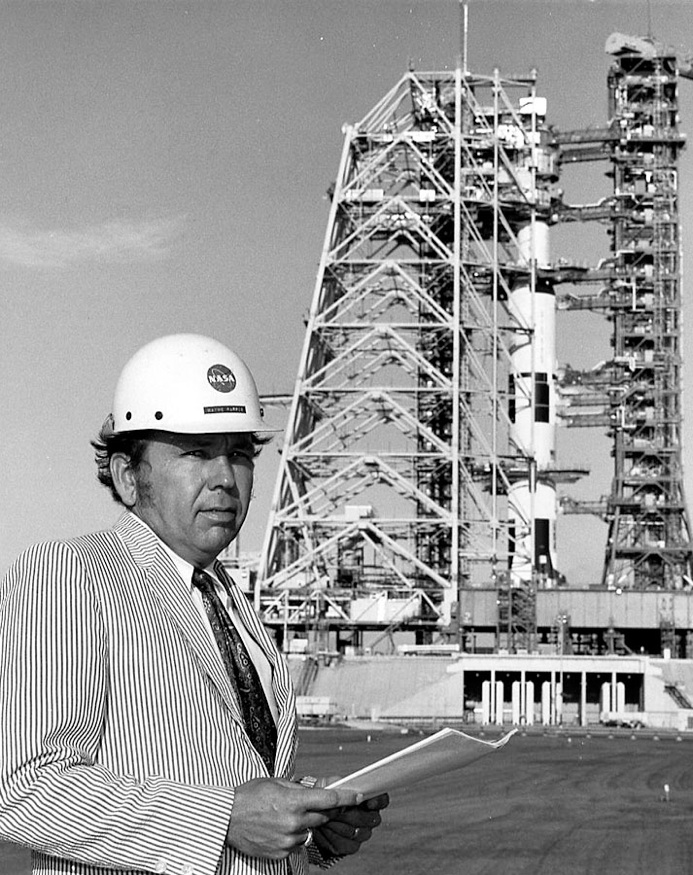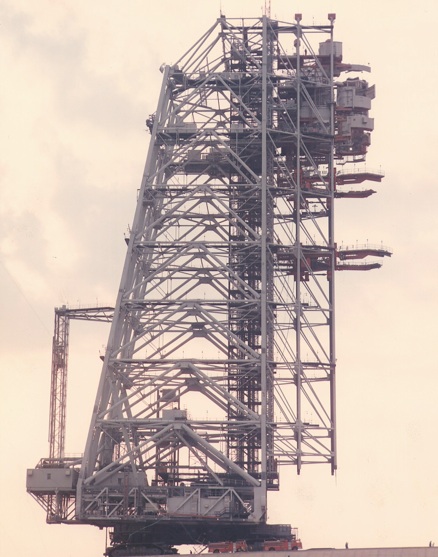Mobile
Service
Structure


Below: Wayne Parris, Mobile Launcher Manager, in front of the Apollo 17 launch vehicle at LC 39A. Note how the cylindrical work platforms at the top of the MSS completely enshroud the Apollo Command Module, Service Module, and the SLA (adapter section containing the Lunar Module). NASA photo AP17-KSC-72P-394.



The Mobile Service Structure (MSS) provided access to the launch vehicle and spacecraft while the vehicle was on the launch pad. It was a separate structure that was moved onto to the launch pad shortly after the Mobile Launcher was rolled out to the pad. After placing the Mobile Launcher onto the launch pad, the crawler/transporter retrieved the MSS from its parking place alongside the Crawlerway and took it to the pad. The MSS remained in position around the launch vehicle until the day before the scheduled launch.
The MSS was originally conceived as the “Arming Tower.” Prior to launch, a number of explosive devices needed to be installed in the launch vehicle. These included the linear shaped charges that would separate the stages of the vehicle in flight, as well as explosives along the fuel and oxidizer tanks for “fuel dispersion,” which would destroy the vehicle in flight if it veered off course. For safety reasons, it was felt that these should be installed at the launch pad rather than in the confines of the Vehicle Assembly Building. As the Apollo/Saturn design matured, the MSS evolved into a structure that would enable technicians to work on the vehicle as it sat on the launch pad. It also provided the spacecraft with a degree of protection from the weather.
Left: The ungainly-looking MSS is shown being rolled onto the launch pad atop a crawler/transporter. Key elements of the structure included the work platforms (sticking out on from the upper and middle right-hand side of the MSS), the elevator (vertical column approximately in the center of the MSS), and the elevator counterweight (at lower left of the MSS).
The large work platforms at upper right completely surrounded the spacecraft and the upper section of the S-IVB stage, which held the Lunar Module. From these platforms, technicians could make last-minute changes to the flight hardware. For example, the US flag planted on the Moon on Apollo 11, and the “We came in peace” plaque on the LM’s leg, were installed on Eagle less than 24 hours before Apollo 11’s launch.
The MSS was 402 feet tall and weighed 12 million pounds.

Above left: Final minutes of the MSS being rolled into place atop the launch pad.
Above right: The MSS in position next to the AS-500F facilities integration vehicle.
Below: Nice view of the MSS work platforms near the Skylab 2 spacecraft on pad 39B. (Note the Saturn V carrying the Orbital Workshop on Pad 39A in the background.)
(c) 2012 Jonathan H. Ward